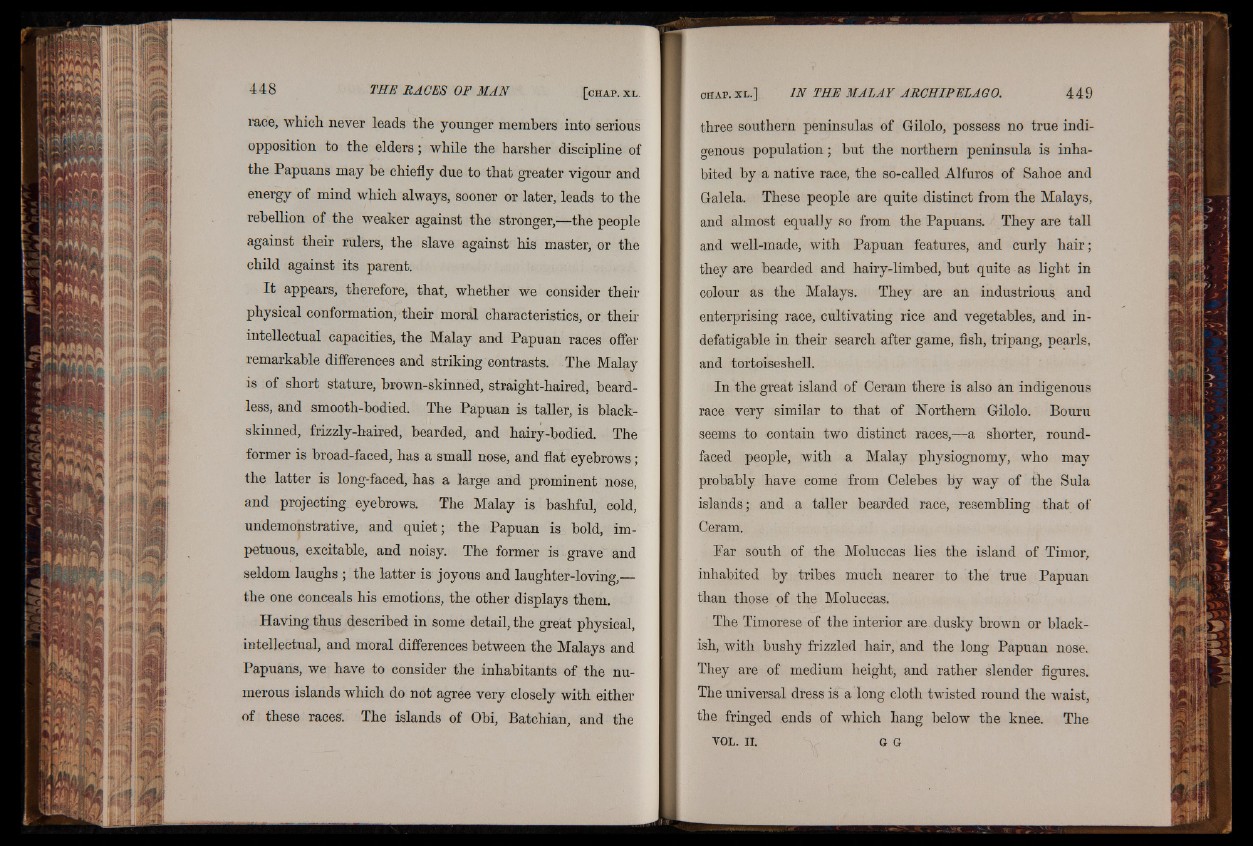
race, which never leads the younger members into serious
opposition to the elders; while the harsher discipline of
the Papuans may be chiefly due to that greater vigour and
energy of mind which always, sooner or later, leads to the
rebellion of the weaker against the stronger,—the people
against their rulers, the slave against his master, or the
child against its parent.
It appears, therefore, that, whether we consider their
physical conformation, their moral characteristics, or their
intellectual capacities, the Malay and Papuan races offer
remarkable differences and striking contrasts. The Malay
is of short stature, brown-skinned, straight-haired, beardless,
and smooth-bodied. The Papuan is taller, is blackskinned,
frizzly-haired, bearded, and hairy-bodied. The
former is broad-faced, has a small nose, and flat eyebrows;
the latter is long-faced, has a large and prominent nose,
and projecting eyebrows. The Malay is bashful, cold,
undemonstrative, and quiet ; the Papuan is bold, impetuous,
excitable, and noisy. The former is grave and
seldom laughs ; the latter is joyous and laughter-loving,—
the one conceals his emotions, the other displays them.
Having thus described in some detail, the great physical,
intellectual, and moral differences between the Malays and
Papuans, we have to consider the inhabitants of the numerous
islands which do not agree very closely with either
of these races. The islands of Obi, Batchian, and the
three southern peninsulas of Gilolo, possess no true indigenous
population; but the northern peninsula is inhabited
by a native race, the so-called Alfuros of Sahoe and
Galela. These people are quite distinct from the Malays,
and almost equally so from the Papuans. They are tall
and well-made, with Papuan features, and curly hair;
they are bearded and hairy-limbed, but quite as light in
colour as the Malays. They are an industrious and
enterprising race, cultivating rice and vegetables, and indefatigable
in their search after game, fish, tripang, pearls,
and tortoiseshell.
In the great island of Ceram there is also an indigenous
race very similar to that of Northern Gilolo. Bouru
seems to contain two distinct races,—a shorter, round-
faced people, with a Malay physiognomy, who may
probably have come from Celebes by way of the Sula
islands; and a taller bearded race, resembling that of
Ceram.
Far south of the Moluccas lies the island of Timor,
inhabited by tribes much nearer to the true Papuan
than those of the Moluccas.
The Timorese of the interior are. dusky brown or blackish,
with bushy frizzled hair, and the long Papuan nose.
They are of medium height, and rather slender figures.
The universal dress is a long cloth twisted round the waist,
the fringed ends of which hang below the knee. The
VOL. II. G G